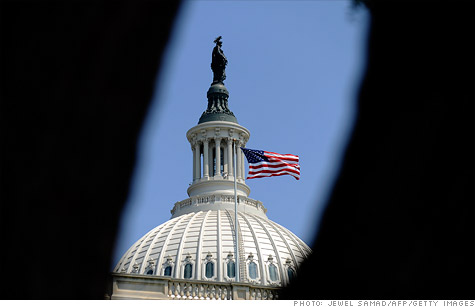
Goodbye, AAA.
NEW YORK (CNNMoney) -- Credit rating agency Standard and Poor's made good on its saber-rattling on Friday, and downgraded U.S. debt.
The move is unprecedented -- and the effects unclear.
So what exactly is going on here?
Rating agencies -- S&P, Moody's and Fitch -- analyze risk and give debt a "grade" that reflects the borrower's ability to pay the underlying loans. The safest bets are stamped AAA. That's where U.S. debt has stood for years.
Moody's first assigned the United States a AAA rating in 1917. The country's new S&P rating is AA+ -- still strong, but not the highest.
The downgrade puts the U.S. debt rating on par with that of Belgium, but below countries like the United Kingdom and Australia.
Why did this happen now? S&P gave two primary reasons for downgrading U.S. debt: The nation's fiscal path and its broken political system.
The agency has been harping on those two issues for months. S&P argues that the U.S. debt-to-GDP trajectory is unsustainable, and that the politics involved are so caustic that lawmakers are unable to make the tough choices needed to correct the problem.
During the debt ceiling debate, lawmakers blew their big chance to make a difference.
To avoid a downgrade, S&P said the United States needed to not only raise the debt ceiling, but also develop a "credible" plan to tackle the nation's long-term debt.
The agency has indicated it preferred a deal that would have reduced deficits by $4 trillion over ten years. Instead, lawmakers settled for a measure that will cut only $2.5 trillion.
What does a downgrade mean for my finances? Well, it's tough to say. Remember, this has never happened before to the United States.
And it doesn't necessarily mean disaster for your money. The United States has not been downgraded to "junk" status, like say, Greece. The rating is still very high -- just not tops.
Bottom line -- it's not going to help matters, especially with the economy already in a soft patch.
Some reaction is expected in the stock market. Major indexes around the world were battered last week, and a downgrade can only increase uncertainty and fear.
It's unclear how the Treasury market will react. Some experts think yields could spike -- and that could impact consumers by leading to rate hikes on items like car loans, mortgages and student loans.
But others predict investors will shrug off the downgrade. Why? Because the U.S. fiscal situation is well known, and S&P is not basing its rating on any information that is not already available.
Can the U.S. return to a AAA rating? It can! But it will be tough, and it won't happen for a while.
John Chambers, the head of sovereign ratings at S&P, told CNN that his agency's decision is likely to have a long-term impact.
"Once you lose your AAA, it doesn't usually bounce back," he said.
It's unclear exactly what steps are needed to change S&P's mind. A source familiar with the discussion said Friday evening that the rating agency had not discussed a return to AAA status with the Treasury Department.
Was this avoidable? Yes.
S&P has gone out of its way to point to the political brinkmanship over the debt ceiling as a key reason for the downgrade.
That puts the blame squarely on lawmakers -- and the political culture they cultivate and participate in.
"The first thing [lawmakers] could have done is to have raised the debt ceilng in a timely manner so that much of this debate had been avoided to begin with, as it had done 60 or 70 times since 1960 without that much debate," Chambers said.
Is one party to blame over the other?
"This is a problem that's been a long time in the making," Chambers said
In a sign that message had not been received, lawmakers and candidates for political office issued a slew of partisan statements Friday night, casting blame and throwing rhetorical stones just hours after the downgrade was announced. ![]()
| Overnight Avg Rate | Latest | Change | Last Week |
|---|---|---|---|
| 30 yr fixed | 3.80% | 3.88% | |
| 15 yr fixed | 3.20% | 3.23% | |
| 5/1 ARM | 3.84% | 3.88% | |
| 30 yr refi | 3.82% | 3.93% | |
| 15 yr refi | 3.20% | 3.23% |
Today's featured rates:
| Latest Report | Next Update |
|---|---|
| Home prices | Aug 28 |
| Consumer confidence | Aug 28 |
| GDP | Aug 29 |
| Manufacturing (ISM) | Sept 4 |
| Jobs | Sept 7 |
| Inflation (CPI) | Sept 14 |
| Retail sales | Sept 14 |